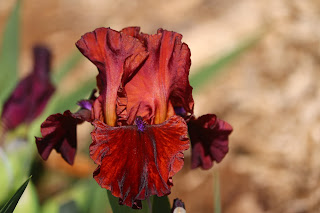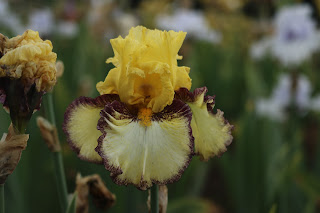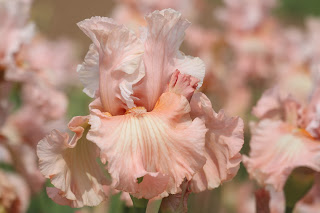By Vanessa Spady
My blog updates and my actual gardening progress are a bit out of step, so this post is about the fun we had planting our first set of rhizomes way back in October. I encourage you to read it, even though, since this part of the process was both fun to do and funny to read about.
Although I work, and have six dogs, eleven sheep and an orange cat (orange cat owners know what that means) I somehow manage to spend the bulk of my time gardening. I do this by choice, and on days like the day I am about to tell you all about, I garden instead of all the things I should be doing. (Note: if anyone can tell me the four-letter word equivalent for “should” I’ll use that instead.)
I have two forms of proof that I spent the bulk of that weekend in the garden. First, the inside of my house could convince you that border collies have opposable thumbs, and second, I was finally making visible progress on our iris project. While I dream of coming home to a beautifully clean home and a delicious, fresh-cooked meal, it turns out—to my surprise—that I don’t have a wife. Normally, my utterly darling husband steps up and makes a huge dent in the household chores, but he was out of town that weekend, and so I came home to the mess I’d made the day before, after a long day in the garden... (Honey, did I mention how much I appreciate you? Consider this a second reminder that you’re the best.)
So, now it’s 9:30 at night, I’m eating from-the-freezer stir-fry, and having just unloaded and re-loaded the dishwasher, I can now sit down and gush and crow and preen over my garden photos (none of which show the true measure of the accomplishment I feel!). I’m that delightful combination of excited and bushed, which is a nice way to wrap up the weekend. And I get to share my progress photos with you, which makes it much more fun. But first, of course, I have to tell you what got done!
From previous posts, know you that I’d cleared an area of the yard with a gentle slope for our great planting endeavor. I also procured (donated!) kiddie pools, tires, and pallets. Drip irrigation materials are on hand, and the rhizomes have all arrived (bought online, and from the San Fernando Valley Iris Society, who are just the loveliest people around). Six yards of very nice loamy, amended soil was delivered. So, no more obstacles, right?
P.S. Whomever came up with the expression “dirt cheap” has never had a dump-truck load of it delivered to their house.
“Hooray!” I exclaimed. “I can start planting now!”
But, that was premature. Because, you know, I’m not just going to stick them in the beds willy-nilly. There has to be a plan! A grand scheme! An over-arching concept! Right? I mean, I’m starting from bare dirt in about an acre of land. This is my big chance to design something amazing, and brilliant. Something that will end up in high-end gardening magazines, and be the first result when you search “gorgeous iris garden” and also be the ideal for all future iris lovers across the globe. I can’t just stick them in a kiddie pool and call it genius! There must be A Plan!
This, friends, is where the magic of gardening begins to ebb away, and the practical realities of being a Type-A overachiever with tendencies towards the grandiose starts to inhibit the actual gardening part of having a garden. I kid you not, there are probably a dozen steps between the dirt arriving, and the first iris rhizome getting planted in that dirt. I’ve had a few sips of wine, so it’s starting to be amusing to me...feel free to laugh along with me.
The good news (for me) is that in addition to being Type-A, I’m also very practical. I realized that I was not quite ready to design the most stunning garden of all time, and that just having a successful growing season was an excellent goal for this first planting year. Sufficiently self-chastened, I took some (more) advice from my sister, and created a visual catalog of all the iris I ordered, as well as all the named iris I already own. It turns out to be approximately 95 named iris. (The hundreds and hundreds of iris with missing names have earned their own post, so we’ll talk about those another time.) Luckily for me, I used to be an art director and graphic designer, and I very quickly assembled an excellent and clever (if I do say so myself) method of creating my very own iris catalog. Arrange-as-you-like printed envelopes:
 This way, I can lay them out to create optimal color combinations without dragging my computer around the garden. Or worse, relying on my memory...
This way, I can lay them out to create optimal color combinations without dragging my computer around the garden. Or worse, relying on my memory...
Any tags that come with the rhizome go into the envelope. I feel so clever.
Of course, my goals for the garden are different from most commercial growers’ goals and requirements. I could have just planted them alphabetically! Or by type (“Tall beardeds on the left, folks, and intermediates on the right...”), but I created a slightly more challenging rubric of by-season and by complimentary-color combination. Which is to say, all the early bloomers are together, and then arranged in color combinations that enhance and support the beauty and uniqueness of each variety. Then the mid-season bloomers are together, and the late bloomers are together, etc, all arranged by a totally subjective and probably not-entirely-perfect color-enhancement and combination that, now that I’m typing it, sounds almost silly.
But, truly, a lot of thought went into which iris should be planted near which other iris. In my personal yard, I have what I call my yellow garden. I have combined many of my favorite yellow and yellow-ish plants in one area, and they all bloom their own variety of yellows, creating a really lovely and inviting spectacle. But I noticed when iris-shopping that often all the white iris (for example) look indistinguishable when they are planted together. There are subtle differences, of course, but the eye wearies of all white, or all blue, or all deep purple. And creating contrasts, and appealing color combinations really boosts the value of some of the more average or mundane blooms. A yellow bloom loses it’s zing next to a similar yellow bloom. But either of them in contrast with a vibrant purple (or reds, or pinks) become a vital part of a visually exciting tableau. Yeah, I just said that!
So, I printed out all the named iris stats onto envelopes, in full color. Then I separated them into bloom season (early, mid, late). And then began the fun of deciding which combinations of rhizomes should be created, and into which kind of bed (tires, raised beds, or kiddie pools) they should be planted. Now, I am going to toot my own horn again, and say that normally I am very very good at estimating how much time a task will take. And normally, I will brag about how that is one of my superpowers. Because of that, I will happily confess that I grossly, massively, and completely underestimated how long it would take me to create the layouts for the beds.
I figured it would take about an hour. It took closer to four. That was with Chris’ help. And that was after I had printed the envelopes, broken them into bloom-season groups, and made a preliminary layout. I was utterly unable to make the process faster, and I suddenly understood the appeal of planting them in alphabetical order.
When I woke up that morning at seven, I thought I would have everything planted by noon. Looking back, that is so naively adorable! I wrapped at sundown, because I still needed hardware and knew I wouldn’t get back before dark. Also, the dogs called and were threatening to see what they could whip up from leftovers and whatever was in the freezer... I had to call it a day. All the mid-season bloomers are planted in the raised beds, and the late-bloomers are the next to go in.
The great news is that I think we have a very attractive layout for each bed, and we will be able use all three types of beds for this test planting. I painted the tires for the early bloomers (because black tires in our climate will simply bake the roots of any rhizomes), so they finally got planted, too. Then I finished the drip system installation, and then... well, if you garden, you know there will always be something else. It will probably be weeding. I’m convinced the runoff will create beautiful green stripes of weeds in downhill rivulets from our beds... and then the gophers will really have something to think about!
Before that, though, here is a pictorial of how that first day commenced:
It started out hot, so we set up in the shade. You can see our magical raw materials: tires, raised beds, and lots of rhizomes. A thousand thanks to Chris for her help and delightful company.
 You don’t have to guess that it’s genius at work when you see we’re using the hood of the car to lay out our magic envelopes and create the masterful final designs (cough, cough).
You don’t have to guess that it’s genius at work when you see we’re using the hood of the car to lay out our magic envelopes and create the masterful final designs (cough, cough).
I was pretty convinced we were going to need dozens of beds and walkways for the all the iris I ordered... and ha-ha, uh, no. This is pretty much the final configuration: early bloomers in the tires, midseason bloomers in the raised beds, and late bloomers in the kiddie pools. This all the room it takes to plant approximately 140 rhizomes. Yeah, I was surprised, too!
This was the trial layout before the tires were painted. The final layout is pretty much just like this preliminary version.
This is where the magic happened that first day. We laid out weed-blocking fabric, and then on top of that, we rolled out fine-grade wire mesh, to discourage the below-ground critters from coming up into the beds from underneath. I use the word “discourage” realizing they may come through anyhow, but at least we made it challenging!
You, too, can work for nine hours and have this to show for it! But, finally, rhizomes in the soil. Once the layout was in the database, we removed all the lovely tags, so the plants can just look natural. And relaxed. Like me.
There has been so much progress since these shots, so keep your eyes peeled for the next update. I can’t wait to share it all with you! And I keep my promises: here is a lovely photo of Doctor Who, a dynamite performer that I just love.
'Doctor Who' (George Sutton, R. 2009). Seedling U-740. TB, 37" (94 cm), Midseason to late bloom. Standards and style arms chinese yellow (RHS 20D); Falls beetroot purple (71A), chinese yellow and beetroot burst pattern; beards spanish orange; ruffled; slight sweet fragrance. 'Tropical Delight' X 'Snowed In'. Sutton 2010. Honorable Mention 2012.
.JPG)
.JPG)
.JPG)
.JPG)
.JPG)

.JPG)
.JPG)
.JPG)
.JPG)

.JPG)


.JPG)




.JPG)


































